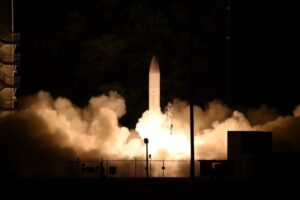The Army won’t meet its aim to field a first operational battery of its Long Range Hypersonic Weapon (LRHW) by the end of fiscal year 2023, with the goal now set for the end of the calendar year.
Doug Bush, the Army’s top acquisition official, confirmed the update on Tuesday, which follows a canceled LRHW earlier this month that he said was due a “weapon-related” issue.

“There was a flaw that triggered a ‘don’t shoot,’ basically,” Bush told reporters. “I wouldn’t say we anticipated it or we would have fixed it. But I think it’s an example, though, of when you take the missile and you put it into what’s going to be an operational launcher, this where you learn [about] integration — it might sound simple, but it’s not — [and] where the challenges are.”
Bush said the Army Rapid Capabilities and Critical Technologies’ (RCCTO) work to develop LRHW is the equivalent of a Major Defense Acqusition program, in terms of fielding a brand new weapon system.
“It is extremely complicated. It’s an entirely new missile, new launcher, new fire control,” Bush said. “I think three months in the grand scheme of things is not that big of a deal, but that’s for others to judge, especially with a system this complicated.”
The Army previously noted the Sept. 6 test was set to take place at Cape Canaveral Space Force Station in Florida, before it was scrapped following pre-flight checks (Defense Daily, Sept. 7).
Bush said the recently canceled test was not designed to be a “full-up operational test…but close.”
“A lot of soldiers were involved. We used the real hardware. We used the real software. So, unfortunately, we had that glitch. But we believe we have a test campaign scheduled for the rest of the year that could still, if it goes well, enable [an] end of the year thumbs-up on the fielding of the initial first battery. So we’ll see,” Bush said.
A flight test planned for early March at Cape Canaveral was also called off following pre-flight checks (Defense Daily, March 10).
The Army’s LRHW, which has been in development for about four years, will share the same all-up missile round and canister as well as the Common Hypersonic Glide Body (C-HGB) with the Navy’s Conventional Prompt Strike program.
In 2019, the Army chose Lockheed Martin [LMT] to serve as the weapon systems integrator for the LRHW, which will be fired from a truck, while Dynetics [LDOS] is tasked with producing the C-HGB.
The Army completed fielding of the ground equipment for its first prototype hypersonic weapon battery, minus the live rounds, in the fall of 2021 to the soldiers from the I Corps’ 5th Battalion, 3rd Field Artillery Regiment, 17th Field Artillery Brigade at Joint Base Lewis-McChord in Washington and who have been testing on the equipment since then.